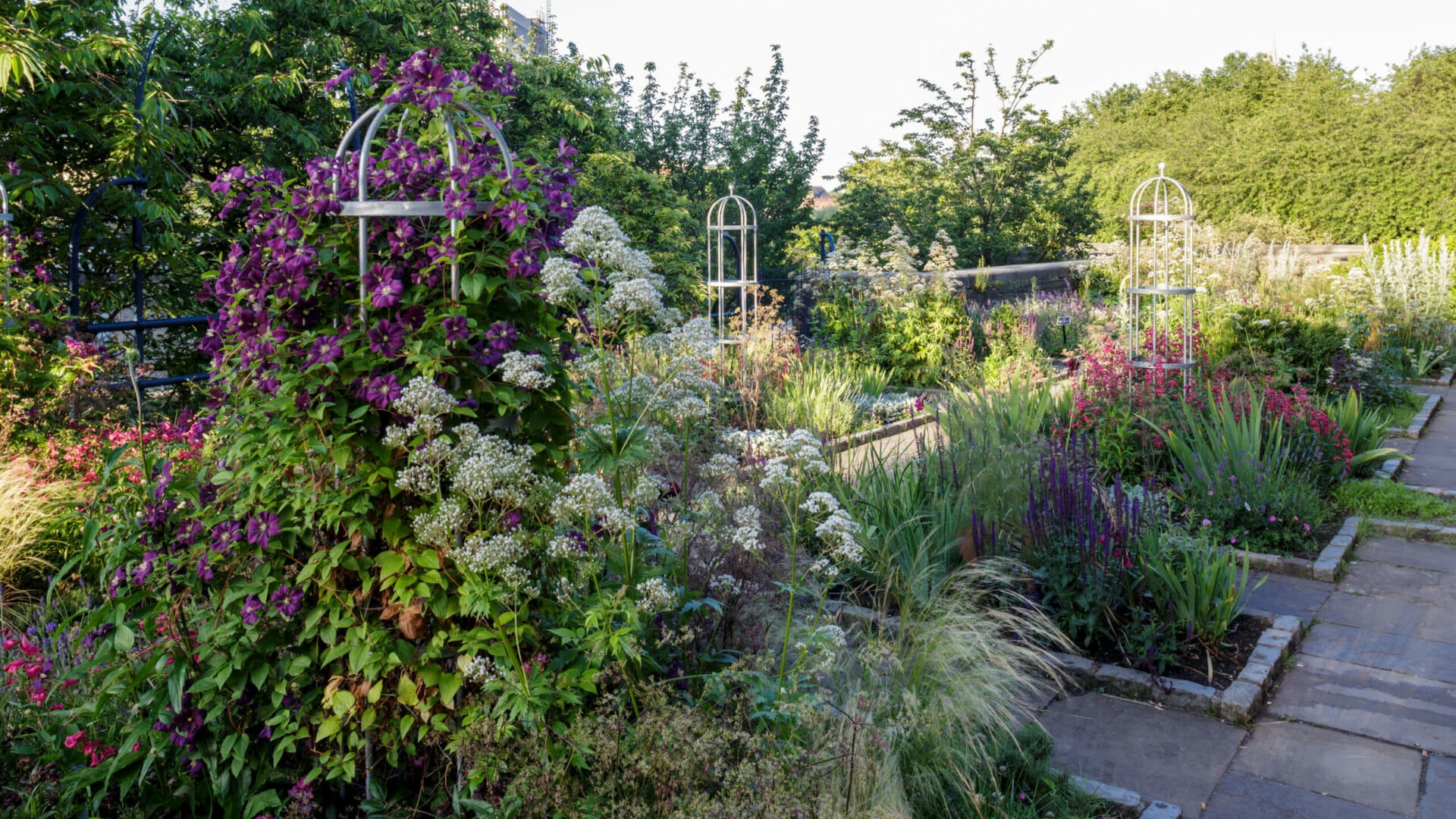
So you want to know how to create a sensory garden with perennials? Well, you’ve come to the right place! In this article, we’re going to explore the wonderful world of sensory gardens and show you how to bring one to life using beautiful perennial plants.
Are you ready to embark on this exciting gardening adventure? Let’s dive in!
Perennial plants, with their enduring beauty and longevity, are the perfect choice for creating a sensory garden that can be enjoyed year after year. These amazing plants come back season after season, bringing vibrant blooms, lush foliage, and captivating aromas to your garden.
Plus, they require less maintenance than annuals, making them ideal for busy gardeners or those new to gardening.
How to Create a Sensory Garden with Perennials
- Choose a variety of perennials that offer different sensory experiences, such as fragrant flowers or textured leaves.
- Select a suitable location for your garden, considering sunlight and soil conditions.
- Prepare the soil by removing weeds and adding organic matter.
- Plant your perennials, ensuring proper spacing and depth.
- Water and mulch your garden regularly, and maintain it by removing spent flowers and foliage.
Create a beautiful and engaging sensory garden with perennials by following these simple steps. Your garden will provide a delightful experience for all your senses!
Choosing the Right Perennials for Your Sensory Garden
A successful sensory garden starts with carefully selecting the right perennials. When choosing plants, consider their sensory attributes such as color, texture, fragrance, and taste. Opt for a mix of plants that bloom at various times throughout the year to ensure a continuous sensory experience.
Some popular choices for a sensory garden include lavender, roses, peonies, irises, and herbs such as mint and basil.
The Sights and Sounds of a Sensory Garden
In a sensory garden, visual and auditory elements play an important role in creating a captivating experience. Incorporate plants with different colors and textures to create visual interest and contrast. Consider adding ornamental grasses that sway with the wind or plants with unique leaf shapes.
To enhance the auditory experience, include wind chimes, a water feature like a small pond or fountain, or plants that rustle in the breeze. These elements add a sense of tranquility and relaxation to your sensory garden.
Tips for Harnessing Fragrance and Texture
Fragrance and texture are key components of a sensory garden. Explore plants with delightful scents, such as roses, lavender, jasmine, or sweet peas. Group these fragrant plants together to create concentrated pockets of aroma. For texture, select plants with different foliage types, such as plants with soft leaves (like lamb’s ear) and plants with spiky leaves (like yucca).
Incorporate plants with varying heights and growth habits to add an extra layer of texture to your garden.
Elements of a Successful Sensory Garden
To create a truly immersive sensory garden, it’s important to consider the different elements that contribute to the overall experience. Here are some key elements to incorporate:
Pathways and Accessible Design
Accessible pathways are essential in a sensory garden to ensure everyone can fully enjoy the experience. Create clear and wide pathways that accommodate wheelchair users or individuals with mobility challenges. Consider using materials like gravel or stepping stones to add texture underfoot.
Sensory Stations
Designate specific areas in your garden as sensory stations. These can be small seating areas or nooks where visitors can engage with specific plants or elements. For example, create a station with fragrant plants and a bench where visitors can relax and enjoy their scents.
Water Features
Water features not only create a serene atmosphere but also provide auditory stimulation. Incorporate a small pond, a cascading waterfall, or a bubbling fountain to add a sense of tranquility to your sensory garden. The sound of running water can be quite soothing.
Plant Selection and Placement
Strategically select and place your perennials to maximize their sensory impact. Group plants with similar attributes together, such as aromatic herbs in one area and vibrant flowers in another. This arrangement will create distinct zones within your garden and allow visitors to easily navigate through the different sensory experiences.
Seating Areas and Rest Spaces
Include seating areas and rest spaces throughout your sensory garden. Benches or comfortable seating options provide opportunities for visitors to sit and take in the beauty of the garden. Ensure these seating areas blend harmoniously with the overall garden design.
Edible Plants
To engage the sense of taste, incorporate edible plants into your sensory garden. Herbs like basil, thyme, and mint not only provide delightful aromas but can also be used in cooking. Consider planting fruit trees or berry bushes as well, allowing visitors to sample fresh fruits or berries when they are in season.
Beneficial Insects and Wildlife
Invite beneficial insects and wildlife into your sensory garden by incorporating plants that attract butterflies, bees, and birds. These creatures add movement and life to the garden, enhancing the overall sensory experience. Plant nectar-rich flowers like coneflowers, cosmos, and zinnias to attract pollinators.
In conclusion, creating a sensory garden with perennials offers a unique and enchanting experience. By carefully selecting and arranging plants, incorporating various elements, and considering accessibility and seating, you can design a garden that engages all the senses.
Embrace the beauty and harmony of nature as you create your own sensory oasis. So, gather your favorite perennials and begin your journey towards a sensory garden that will delight and inspire.
Frequently Asked Questions
Are you interested in creating a sensory garden with perennials? Here are some commonly asked questions to help you get started!
1. What are some important factors to consider when choosing perennials for a sensory garden?
When selecting perennials for a sensory garden, it’s crucial to consider several factors. First, think about the sensory elements you want to incorporate: fragrance, texture, color, and sound. Choose plants that stimulate the senses you want to highlight. Second, consider the growing conditions of your garden, including sunlight, soil type, and moisture levels.
Different perennials thrive in different environments, so make sure to choose plants that are well-suited to your garden’s conditions. Finally, think about maintenance. Select low-maintenance perennials that won’t require excessive care or pruning.
By carefully considering these factors, you can choose perennials that will thrive in your sensory garden and provide a delightful sensory experience.
2. What are some popular perennials that can add fragrance to a sensory garden?
There are several popular perennials known for their delightful fragrances, making them excellent choices for a sensory garden. Lavender, with its calming scent, is a favorite among many gardeners. Roses also come in a wide range of fragrances, from sweet to spicy, and can add a romantic touch to your garden.
Another fragrant perennial is the gardenia, which produces beautiful white flowers with a captivating aroma. Mint is also a great option to add a refreshing scent to your sensory garden. Consider combining different fragrant perennials to create a diverse and aromatic sensory experience in your garden.
Remember to place fragrant perennials in areas where the scent can easily be enjoyed, such as near seating areas or pathways.
3. How can I incorporate texture into my sensory garden using perennials?
Texture is an essential element in a sensory garden, as it adds visual interest and tactile stimulation. To incorporate texture using perennials, consider plants with diverse foliage characteristics. For example, hostas have large, broad leaves that are soft to the touch, while plants like yucca have stiff, spiky leaves.
Ornamental grasses, with their feathery or cascading foliage, can also provide interesting textures. Additionally, look for perennials with unique blooms, such as the fuzzy flowers of lamb’s ear or the velvety petals of some varieties of hollyhock. By combining perennials with different textures, you can create a visually stunning and sensory-rich garden.
When designing your garden, think about placing plants with contrasting textures next to each other to enhance the overall sensory experience.
4. Can you recommend perennials that attract butterflies and hummingbirds to a sensory garden?
A sensory garden can come alive with the vibrant colors and graceful movements of butterflies and hummingbirds. To attract these winged visitors, consider planting perennials that they find irresistible.
Butterfly favorites include flowers such as coneflowers, black-eyed Susans, and bee balm, which provide nectar and landing platforms. Hummingbirds are attracted to tube-shaped flowers with bright colors, such as trumpet vine, cardinal flower, and salvia.
By incorporating these butterfly- and hummingbird-friendly perennials into your sensory garden, you’ll not only create a visually appealing space but also invite enchanting visitors to enjoy the garden with you.
5. How can I create a soothing soundscape in my sensory garden using perennials?
Sound can greatly enhance the sensory experience in a garden. To create a soothing soundscape using perennials, consider plants that produce gentle rustling sounds or those that attract singing birds. Ornamental grasses, such as feather reed grass or maiden grass, sway in the breeze and create a calming rustling sound.
Wind chimes strategically placed near perennials can also add melodic tones to your garden. Additionally, select perennials that attract birds, such as sunflowers or coneflowers, as their chirping and singing can provide a natural symphony.
By carefully choosing perennials that contribute to the soundscape of your garden, you can create a serene and tranquil environment where you can unwind and relax.
So, to create a sensory garden with perennials, you need to follow these steps. First, choose plants that appeal to your senses, like ones with pleasant scents or vibrant colors. Next, consider different textures by including plants with soft leaves or fuzzy stems.
Don’t forget about sound – opt for plants that rustle in the wind. Finally, provide opportunities for taste, like with herbs or edible flowers. Remember, a sensory garden is about engaging your senses and creating a space that brings joy and relaxation. Have fun and happy gardening!



